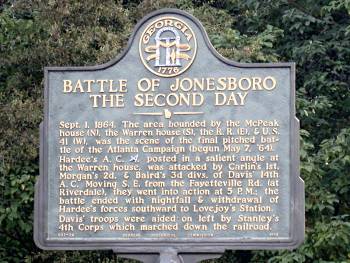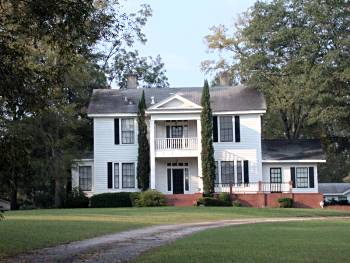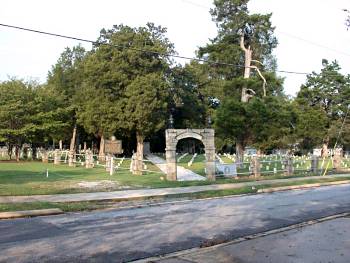
| Atlanta Campaign Home |
| Civil War Album Home |
 While
Hood’s army had suffered crippling setbacks at Peachtree Creek and the
Battle of Atlanta and could no longer mount viable offensive operations, it
was more than sufficient to man the massive fortifications surrounding
Atlanta. Since Sherman’s investment of the city was not complete, Hood could
hold out indefinitely as long as his railroad supply lines were intact.
Sherman knew that direct assaults were inadvisable and so he began to plan
for movements to the west of Atlanta with an eye to severing the West Point
and Macon railroads that ran into the city from the southwest. On July 26th,
Gen. O. O. Howard, who had taken over command of the Army of the Tennessee
following McPherson’s death, was sent in a wide flanking maneuver to the
vicinity of Ezra Methodist Church. Hood, sensing the danger to his exposed
railroad, sent two corps to meet the threat. In a series of uncoordinated
assaults, Hood’s army lost another 5,000 men and were thrown back at every
point. President Jefferson Davis, upon hearing of the action, sent Hood a
telegram, "Stop attacking before you completely destroy the army." Davis had
replaced Johnston because he wanted a fight but he had got more than he
bargained for in Hood. The beaten Confederates fell back into the Atlanta
defenses and stalemate ensued for another month. Finally, on August 6th
Sherman renewed his flanking maneuvers to the west of Atlanta. Hardee
extended his lines to meet the threat near Utoy Church and managed to beat
back the Federal assaults. Another long period of Federal shelling of the
entrenched Confederates all along the lines commenced. Frustrated by his
lack of progress, Sherman decided to release his hold on his own supply
line, the Western and Atlantic Railroad, and move his entire army west to
sever Hood’s railroad. On August 25th the shelling abruptly ceased and
Hood’s men found Sherman’s entrenchments abandoned. Mistaking this for a
Federal withdrawal, Atlanta celebrated its deliverance. The truth of the
situation became known on August 30th, however, when the West Point railroad
was cut. Hood immediately dispatched Hardee’s corps to Jonesboro, fifteen
miles south of Atlanta to attempt to save the Macon railroad there. But
Hardee ran headlong into Howard’s army, which had already arrived and
entrenched. The Confederates bloodily repulsed. The following day, going in
for the kill, three Federal divisions assaulted the remains of Hardee’s
corps. The rebels mounted a fierce resistance and horrific Union casualties
staved off complete annihilation for one more day. Hardee managed to
withdraw during the night to Lovejoy Station, further south. The last
remaining railroad supplying Atlanta was cut and Hood was forced to abandon
Atlanta the next day. Sherman wired Washington, "So Atlanta is ours, and
fairly won."
While
Hood’s army had suffered crippling setbacks at Peachtree Creek and the
Battle of Atlanta and could no longer mount viable offensive operations, it
was more than sufficient to man the massive fortifications surrounding
Atlanta. Since Sherman’s investment of the city was not complete, Hood could
hold out indefinitely as long as his railroad supply lines were intact.
Sherman knew that direct assaults were inadvisable and so he began to plan
for movements to the west of Atlanta with an eye to severing the West Point
and Macon railroads that ran into the city from the southwest. On July 26th,
Gen. O. O. Howard, who had taken over command of the Army of the Tennessee
following McPherson’s death, was sent in a wide flanking maneuver to the
vicinity of Ezra Methodist Church. Hood, sensing the danger to his exposed
railroad, sent two corps to meet the threat. In a series of uncoordinated
assaults, Hood’s army lost another 5,000 men and were thrown back at every
point. President Jefferson Davis, upon hearing of the action, sent Hood a
telegram, "Stop attacking before you completely destroy the army." Davis had
replaced Johnston because he wanted a fight but he had got more than he
bargained for in Hood. The beaten Confederates fell back into the Atlanta
defenses and stalemate ensued for another month. Finally, on August 6th
Sherman renewed his flanking maneuvers to the west of Atlanta. Hardee
extended his lines to meet the threat near Utoy Church and managed to beat
back the Federal assaults. Another long period of Federal shelling of the
entrenched Confederates all along the lines commenced. Frustrated by his
lack of progress, Sherman decided to release his hold on his own supply
line, the Western and Atlantic Railroad, and move his entire army west to
sever Hood’s railroad. On August 25th the shelling abruptly ceased and
Hood’s men found Sherman’s entrenchments abandoned. Mistaking this for a
Federal withdrawal, Atlanta celebrated its deliverance. The truth of the
situation became known on August 30th, however, when the West Point railroad
was cut. Hood immediately dispatched Hardee’s corps to Jonesboro, fifteen
miles south of Atlanta to attempt to save the Macon railroad there. But
Hardee ran headlong into Howard’s army, which had already arrived and
entrenched. The Confederates bloodily repulsed. The following day, going in
for the kill, three Federal divisions assaulted the remains of Hardee’s
corps. The rebels mounted a fierce resistance and horrific Union casualties
staved off complete annihilation for one more day. Hardee managed to
withdraw during the night to Lovejoy Station, further south. The last
remaining railroad supplying Atlanta was cut and Hood was forced to abandon
Atlanta the next day. Sherman wired Washington, "So Atlanta is ours, and
fairly won."
|
|
||
 |
 |
|
|
(10-02) Looking north along GA 138 from Jonesboro |
(10-02) Enlarge
GA 138, Jonesboro |
|
 |
 |
|
|
(10-02) The Warren House (1859) was used during the battle of
Jonesboro as a Confederate Hospital and later as Union headquarters |
(10-02) Patrick Cleburne
Confederate Cemetery in Jonesboro. The Cemetery is on the northern edge
of the city and was the scene of heavy fighting |
|
 |
 |
|
|
(4-2014) Enlarge
Battle of
Utoy Creek marker Bill Bechman photo |
(4-2014) Enlarge Nash
Farm Battlefield Links: 1. Nash Farm Battlefield 2. Battle of Lovejoy's Station - Wikipedia 3. Archaeological Survey - Nash Farm Battlefield Bill Bechman photo |
|
